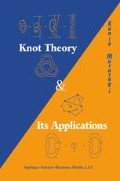Abstract
F.H.C. Crick and J.D. Watson, in one of the most remarkable insights of the 20th century, unraveled the basic structure of DNA. For this profundity into the substance of living matter, they were jointly awarded the Nobel Prize for Medicine in 1962. Essentially, a molecule of DNA may be thought of as two linear strands intertwined in the form of a double helix with a linear axis. A molecule of DNA may also take the form of a ring, and so it can become tangled or knotted. Further, a piece of DNA can break temporarily. While in this broken state the structure of the DNA may undergo a physical change, and finally the DNA will recombine. In fact, in the early 1970s it was discovered that a single enzyme called a (DNA) topoisomerase can facilitate this complete process, from the initial break to the recombination. The reader who might have picked up this book, looked at the title, and then randomly opened the book at this page may think that the publisher has somehow inserted some pages of an elementary textbook on biology here by mistake. But, let us reconsider the above. The double-helix structure of DNA — on some occasions DNA may even have only a single strand — is a geometrical entity, or more precisely, a topological configuration. This topological configuration is itself a manifestation of linking or knotting. Further, it has been shown when a topoisomerase causes DNA to change its form that the process is very similar to what happens locally in the skein diagrams.
Access this chapter
Tax calculation will be finalised at checkout
Purchases are for personal use only
Preview
Unable to display preview. Download preview PDF.
Author information
Authors and Affiliations
Rights and permissions
Copyright information
© 1996 Springer Science+Business Media New York
About this chapter
Cite this chapter
Murasugi, K. (1996). Knot Theory in Molecular Biology. In: Knot Theory and Its Applications. Modern Birkhäuser Classics. Birkhäuser, Boston, MA. https://doi.org/10.1007/978-0-8176-4719-3_14
Download citation
DOI: https://doi.org/10.1007/978-0-8176-4719-3_14
Publisher Name: Birkhäuser, Boston, MA
Print ISBN: 978-0-8176-4718-6
Online ISBN: 978-0-8176-4719-3
eBook Packages: Springer Book Archive

